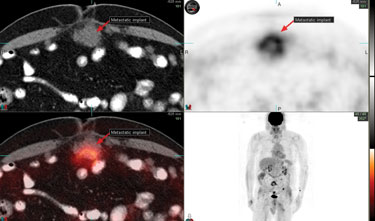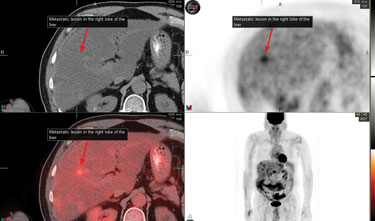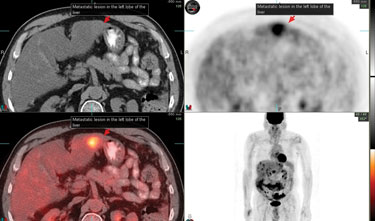Metastatic lesions in the liver seen on PET may not be apparent on non-dedicated CT imaging
The 70-year-old patient had initially presented with rectal bleeding. Colonoscopy revealed a large ulcerated, fungating, friable mass at 30 cm in the sigmoid colon. Biopsy showed an invasive adenocarcinoma. The imaging studies were negative for metastatic disease. Therefore, the patient subsequently underwent a sigmoid colon resection.
Pathology was consistent with moderately differentiated adenocarcinoma arising from a tubular adenoma with mucinous features; three out of eight lymph nodes were involved. Unfortunately, the surgical margins were positive. He went on to receive adjuvant chemotherapy with a modified FOLFOX6 regimen that was complicated by moderate neuropathy. Since then he has been monitored closely for relapse.
About two years later, the surveillance CT scan showed an enlarging soft tissue mass in the anterior mid-pelvis measuring 2.6 cm and a 3 cm intraluminal mass at the site of anastomosis.
|
Photos by M Ghesani |
The PET/CT study also showed a hypermetabolic omental mass consistent with peritoneal carcinomatosis, a hypermetabolic focus in the area of anastomosis, and an additional hypermetabolic focus in the descending colon without anatomic correlate. The subsequent biopsy confirmed recurrence at the site of anastomosis.
Due to the patient’s underlying comorbidities, he was believed to be a poor candidate for hyperthermic therapy or clinical trial. As such, he received palliative systemic chemotherapy with the FOLFIRI regimen without bevacizumab (Avastin, Genentech), in light of prior history of stroke, peripheral vascular disease and coronary artery disease. He received six cycles, but his last cycle was complicated by viral gastroenteritis resulting in prolonged hospitalization. Thereafter, the patient elected to cancel his therapy and to have expectant management.
|
|
Of note, the restaging follow-up PET/CT after FOLFIRI regimen showed some tumor shrinkage, with reduction in the metabolic activity of the lesions.
A six-month interval follow-up PET/CT again revealed progressive disease corroborated by increasing carcinoembryonic antigen, but the patient largely remained asymptomatic and continued to prefer expectant management.
|
|
He made the same decision after the repeat imaging six months later when imaging again revealed further progressive disease.
This time the PET/CT revealed progression on the liver in the settings of fatty liver infiltration, as well as worsening peritoneal carcinomatosis.
Discussion
PET imaging has significantly changed the work up of a patient with the colorectal cancer, particularly in the setting of recurrence, as well as both hepatic and extrahepatic metastatic disease. Several studies have confirmed that the fusion images of PET and CT improve accuracy, lesion characterization and localization.
Francis et al referred to the retrospective study of 45 patients with colon cancer comparing PET/CT with PET alone; there was a decrease in the number of equivocal readings by 50% for PET/CT. In addition, lesion characterization increased by 30% and accurate localization by 25%. Overall staging accuracy improved from 78% to 89% on a patient-by-patient analysis. In another study of 65 patients with suspected or known colorectal carcinoma, sensitivity and specificity for PET/CT was 96% and 97% compared to 77% and 89% for PET alone. Similarly the sensitivity and specificity for metastases detection were 95% and 98% for PET/CT compared to 66% and 79% for PET alone.
|
|
Khan et al studied 23 patients with clinically suspected liver metastases or presence of extrahepatic disease. Patients had a median age of 59, and all underwent fusion PET/CT. Seven patients (30%) were found to have unexpected metastatic disease, not seen on CT findings in the colorectal metastases group, including patients with hepatic metastases. Three patients had hepatic metastases only, and eight patients had distant disease. Overall, the treatment plan and clinical decision-making were changed in 21 of the 23 patients.
The PET/CT has proved to be useful, especially when conventional CT fails to demonstrate recurrence. Votrubova et al retrospectively compared 84 patients with suspected recurrence. PET/CT correctly detected 40 out of 45 patents with colorectal cancer recurrence, proving that PET/CT is a valuable study to distinguish viable tumor from reactive changes, thereby avoiding unnecessary laparotomies.
Kosugi and colleagues prospectively evaluated PET/CT for staging of lymph nodes and concluded that although PET/CT is markedly more sensitive than CT for detection of N4 lymph node involvement, the number of metastatic lymph nodes is difficult to determine.
Metastatic lesions to the liver from FDG-avid primary malignancies such as colon carcinoma may be readily apparent on PET imaging. It should be noted that these lesions may not be readily apparent on CT imaging of the liver, unless the CT study is optimized with multiphase contrast enhanced acquisition. Presence of diffuse liver disease such as fatty infiltration further compromises ability of CT imaging to detect such lesions.
Liana Makarian, MD is an Oncology Fellow at St Luke’s-Roosevelt Hospital Center.
Munir Ghesani, MD, is Associate Clinical Professor of Radiology at Columbia University College of Physicians and Surgeons and Attending Radiologist at St.Luke’s-Roosevelt Medical Center.
For more information:
- Berger I. Radiology. 2002;225:242.
- Cohade C. J Nucl Med. 2003;44:1797-1803
- Francis DL. J Nucl Med. 2003;44:26P.
- Francis IR. Cancer Imaging. 2005;5 SpecNoA:S68-75.
- Khan. European Journal of Surgical Oncology. 2006;32:564-567
- Kosugi. Hepatogastroenterology. 2008; 5:398-402
- Shiepers C. J Nucl Med. 2003;44:1804-1805.
- Xhuang. Nucl Med Commun. 2000;21:793-798.




